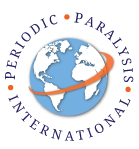Submitted by deb on Mon, 06/27/2011 – 02:22
Hao Cheng, MD
The use of local anaesthetics on patients with periodic paralysis presents some unusual challenges. Many patients report that these agents trigger weakness or paralysis, a phenomenon which is substantiated in medical literature. Some patients also report that the agents do not produce the desired anaesthesia.
The possible problematic agents are: The local anaesthetic agent itself; Lignocaine is usually the standard agent, although other agents are used. Epinephrine (also called Adrenaline), which is added to the local anaesthetic agent, and preservatives which are added to the Epinephrine/Adrenaline.
Serum potassium balance depends on the interaction of internal and external homeostatic mechanisms. Only when one or both systems are disturbed acutely or impaired chronically does plasma K+ change markedly. Epinephrine can cause hypokalemia even in normal subjects. The release of epinephrine during a stress response can acutely lower the plasma K+ by 0.5 – 0.6 mmol/L. When combined with the epinephrine mixed into local anaesthesia, which may lower plasma K+ another 1.0 mmol/L, a patient with Hypokalemic Periodic Paralysis can be put at serious risk of an episode.
Epinephrine is a well recognized provocative factor of attacks in Hypokalemic Periodic Paralysis and its use should be avoided in patients with this disorder. Epinephrine initially increases plasma K+ because of combined alpha and beta receptor stimulation, which releases K+ from the liver. The response is followed by a decrease in plasma K+ caused by beta-receptor stimulation, which enhances K+ uptake by muscle and liver. The end result is a decrease in serum K+.
There are several ways to minimise the chances of problems when a local anaesthetic is needed. The main one would be to do without the Epinephrine/Adrenaline. In most cases it is not needed, and the Doctor or Dentist would be willing to oblige. If having a local anaesthetic for the first time it would be good to use a small test dose of the agent first to gauge any reaction. Any reaction should be apparent in minutes. One would still need to proceed cautiously, even if there was no discernable adverse reaction.
When proceeding with a local anaesthetic, the potential adverse effect on the rest of the body is furthermore proportional to the amount of the agent used, so ask the doctor or dentist to use only the smallest amount and lowest concentration that is necessary for the job.
Local anaesthetics block the initiation and propagation of action potentials by preventing the voltage-dependent increase in Na+ conductance. They appear to act in two main ways: by acting non-specifically on membranes, by virtue of their surface activity, somewhat in the manner of volatile anaesthetics by specifically plugging Na+ channels. While in medical practice this effect is noted; in peripheral and central nerves (hence the beneficial use in anaesthesia); in cardiac muscle (hence the beneficial use of related substances in stabilzing cardiac arrhythmia); in vascular smooth muscle (hence the potential complication of hypotension in their use), we are unaware of any documented effects on skeletal muscle. (The periodic paralyses are generally thought to affect skeletal muscle primarily).
This is not to say that there are not any effects of Local Anaesthetics on skeletal muscle, particularly PP skeletal muscle, but with a lack of research evidence, the above mechanisms are a possible explanation as to why some people with periodic paralysis experience problems with the base component of local anaesthetics. Some local anaesthetic agents have a very long duration of action. Stick to the shorter acting ones like Lignocaine, especially if you (or your patient) has a problem with local anaesthetics.
References:
1. Hahn RG, Löfgren A.; Epinephrine, potassium and the electrocardiogram during regional anaesthesia. Eur J Anaesthesiol. 2000 Feb;17(2):132-7. PMID 10758458
2. Kubota Y, Toyoda Y, Kubota H, Asada A.; Epinephrine in local anesthetics does indeed produce hypokalemia and ECG changes. Anesth Analg. 1993 Oct;77(4):867-8. Comment on: Anesth Analg. 1993 Jan;76(1):162-7. PMID: 8214686
3. Meechan JG.; Plasma potassium changes in hypertensive patients undergoing oral surgery with local anesthetics containing epinephrine. Anesth Prog. 1997 Summer;44(3):106-9. PMID 9481971
4. Vedantham V and Cannon S.; The Position of the Fast-Inactivation Gate during Lidocaine Block of Voltage-gated Na+ Channels. J. Gen. Physiol., Volume 113, Number 1, January 1, 1999 7-16 PMID 9874684
